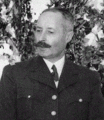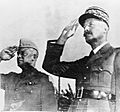Operation Kingpin (World War II) facts for kids
Quick facts for kids Operation Kingpin |
|
|---|---|
| Part of Operation Torch | |
| Operational scope | diplomatic, operational |
| Location | Gibraltar, Algeria |
| Planned by | AFHQ |
| Objective | secure the cooperation of French General Henri Giraud |
| Outcome | successful |
Operation Kingpin was a secret mission during World War II. It was a key part of preparing for Operation Torch, which was a big plan for the Allied forces to invade North Africa. The main goal of Operation Kingpin was to get French General Henri Giraud to help the Allies. He was code-named "Kingpin" for the mission.
This operation followed another secret meeting called Operation Flagpole. In that meeting, U.S. General Mark W. Clark and diplomat Robert Murphy met with French officers who wanted to help the Allies. Operation Kingpin was about bringing General Giraud to Gibraltar to meet with General Dwight D. Eisenhower, who was in charge of Operation Torch, and General Clark. They wanted Giraud to agree to work with them during the invasion.
Contents
Why Operation Kingpin Was Needed

General Giraud was being held under house arrest by the Vichy government in southern France. The Vichy government was the French government that worked with Nazi Germany. Giraud was against the Nazis and was already planning for the day American troops would arrive in France.
He had agreed to support an Allied landing in French North Africa. But he had two main conditions. First, only American troops could be used. Second, he or another French officer had to be the commander of the operation. He felt this was important to keep France in charge of its territories in North Africa.
Giraud chose General Charles Mast to represent him in Algeria. On October 23, General Mast had a secret meeting with U.S. General Mark W. Clark and diplomat Robert Murphy. This meeting was part of Operation Flagpole. They agreed on the invasion, but the Americans only promised Giraud would be in command "as soon as possible."
Giraud, still in France, wanted a written promise that he would be commander within 48 hours of the landing. He also wanted landings in France, not just North Africa. Giraud also said he couldn't leave France before November 20. However, he was later convinced that he needed to go earlier.
The Secret Mission to Get Giraud
On October 26, 1942, Captain Jerauld Wright of the United States Navy was chosen for the mission to get Giraud. This mission was called Operation Kingpin. Giraud refused to work with the British. There were no American submarines close enough to help.
So, Winston Churchill, the British Prime Minister, came up with a clever trick. The British submarine HMS Seraph, commanded by Lieutenant Norman "Bill" Jewell, pretended to be an American submarine. It was briefly called "USS Seraph" and flew the U.S. Navy flag. Captain Wright was technically in charge, but Lieutenant Jewell still ran the submarine. The British crew even tried to speak with American accents they learned from movies! Of course, Giraud knew it was a trick, as Captain Wright had told him.
A British Navy commander, Captain G. B. H. Fawkes, later said that it was very unusual for a U.S. Navy officer to be in charge of a British submarine. This made it the only warship with two captains at the same time.
On October 27, Seraph sailed to the coast of southern France for the secret meeting. The submarine waited near Toulon until it got a signal telling it where to pick up its passengers. On November 5, General Giraud, his son, and three of his officers boarded the submarine. Two days later, they were moved to a PBY Catalina flying boat. This plane was sent from Gibraltar to find the submarine after its radio stopped working. The Catalina then flew to Gibraltar, where Giraud met with Generals Eisenhower and Clark.
Meeting Results and Aftermath
At the meeting, General Eisenhower asked Giraud to take command of French troops in North Africa. He wanted Giraud to tell them to join the Allies during Operation Torch. But Giraud had expected to be in charge of the entire operation, which was Eisenhower's job. He strongly refused to help unless he was the main commander. He said his "honor would be tarnished" and that he would just be a "spectator."
However, by the next morning, Giraud changed his mind. He still refused to go to Algiers right away. He stayed in Gibraltar until November 9.
Meanwhile, French groups in Algeria who supported the Allies had already helped the Allied landings. They even took control of Algiers on the night of November 7–8. Allied troops then occupied the city. But French forces continued to fight back in Oran and Casablanca.
Giraud flew to Algiers on November 9. But his attempt to take command of French forces was not successful. His message telling French troops to stop fighting and join the Allies was ignored.
It turned out that Admiral François Darlan, who happened to be in Algiers, had the real authority. Even Giraud realized this. Even though Darlan had worked with the Vichy government, the Allies recognized him as the head of French forces. On November 10, Darlan ordered the French to stop fighting and join the Allies.
On November 11, German forces moved into and occupied southern France. Talks continued in Algiers. By November 13, Darlan was recognized as the high commissioner of French North and West Africa. Giraud was then appointed commander of all French forces under Darlan. All of this happened without involving the Free French Forces led by General Charles De Gaulle, who claimed to be the true government of France.
Later, on December 24, Admiral Darlan was assassinated. With strong support from the Allies, especially Eisenhower, Giraud was chosen to take his place.
Images for kids





